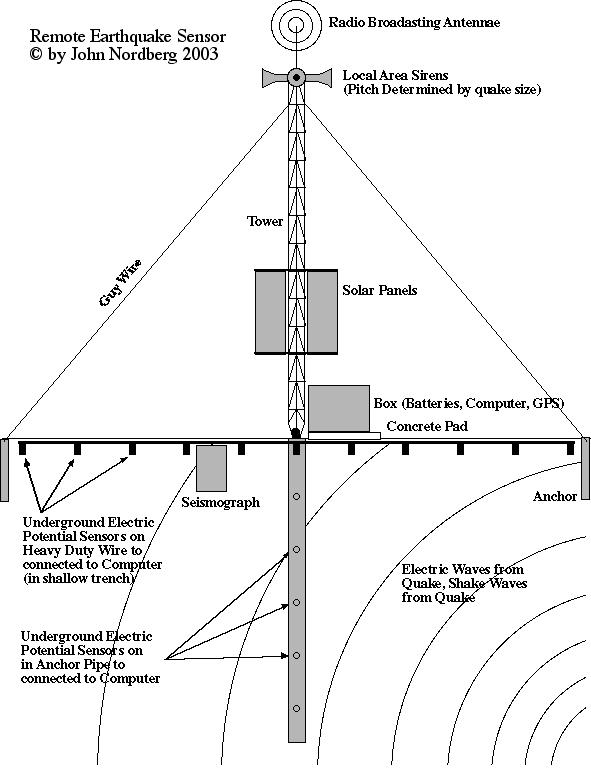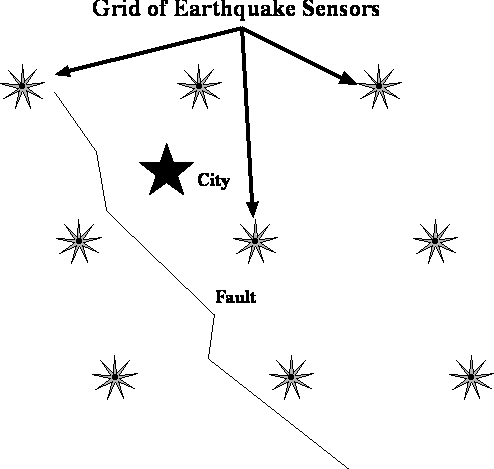New Type of Earthquake Sensor
I envision a new type of earthquake sensor. I have drawn a simple schematic below.

Key Components
The sensor has some key components. They are:
- A Vertical Anchoring Pipe with holes for Electric Potential Sensors
- Two heavy gauge wires buried in trenches just below the surface of the ground at right angles to each other.
- A multitude of Electric Potential Sensors connected to the heavy gauge wires in the below ground trenches.
- A multitude of Electric Potential Sensors in the vertical Anchoring Pipe.
- An above ground box.
- A computer connected to the sensors.
- A software program that can determine differences in electrical potential between the sensors.
- A sampling rate that constantly samples the electric potentials at a rate.
- A system for ranking the size and direction of an earthquake based on the differences of electric potential over time.
- A Tower.
- Tower support Guy Wires and Anchors
- A bank of batteries and a battery charging system.
- Solar Panels for charging the batteries.
- An underground box with a remote controlled seismograph.
- Risk determining software.
- Local Area Sirens.
- Radio Broadcasting Antennae.
- Alert system software that can receive alerts from local area towers and broadcast alerts to local area towers.
How the Sensors Work
When a quake occurs, it is my belief, that there is an electrical signature to the quake, produced by energy released from fracturing rock, that radiates from the quake and which can be sensed by electric potential sensors. Of course there is well-known ground waves that can be picked up in the traditional manner with seismographs. The problem with the ground waves is that when they arrive, the danger from the quake arrives. Just as you can see the flash of lightning before you hear the thunder, picking up the electrical signature of the quake is key to having additional seconds for warning. The sensors would be able to determine the direction and magnitude of the quake.
The Computer Program
The sensors would tell information (both electric and vibrational) about all sizes of quakes. The software in the computer would know the time and magnitude of the forces on the earth's crust from a central computer that broadcasts the daily, hourly, and minute to minute risk for earthquakes based on solid earth tidal forces. See my charts for this information. The software in the warning systems's computer would use information from its own sensors, from other local sensors, from the central computer to constantly determine the risk a the local tower.
How the Local Sirens Work
If the risk, at the local tower, reaches a threshhold (Level C) that would need to be conveyed to the local public, the sirens would sound with a low-level warning. If a the risk is high (Level B), a second, louder, more dangerous sounding sound would be given off. If the risk suddenly becomes dangerous (Level A), or if a large quake has occurred and the seismic waves will reach the area of this tower, then a third sound, representing the most dangerous level would be sounded.
Broadcasting Information
The broacasting of information goes to the following sources:
- Daily information would be given on all local news weather forecasts as to the daily risk on a scale of 1 to 10. (1 low, 10 Dangerous)
- Tower information would be broadcast and rebroadcast to all local towers in order to help the tower's local computer quantify ongoing local risk levels.
- Tower information would be sent back to a main computer for monitoring the tower's functional features, and to be able to analyze data from the macro point-of-view.
- Level C warnings would automatically appear on scrolls on local television and be broadcast to local radio stations, radio alert systems, and personal earthquake warning beeper systems. (Info would also go to public officials, such as police, fire, and emergency services.)
- Level B warnings would automatically interrupt local radio and television broadcasts, would be broadcast to radio alert systems, and broadcast to personal earthquake warning beeper systems. (Info would also go to public officials, such as police, fire, and emergency services.)
- Level A warnings would automatically interrupt local radio and television broadcasts, would be broadcast to radio alert systems, and broadcast to personal earthquake warning beeper systems. (Info would also go to public officials, such as police, fire, and emergency services.)
Benefits of an Earthquake Watch and Warning System
- The public is alerted to the general up and down risk level through the Earthquake Watch System.
- The public is not bothered by the Warning System except once a month for siren tests.
- The public is not bothered by the Warning System unless they live in area that has a large number of quakes, and then only if the Level C risk level is reached.
- The system is automatic, able to give warnings before ground vibrations start, with an advantage over seismographs of seconds to minutes.
- The system is automatic, in the sense that warnings are based not upon hunches or educated guesses by people, but by local, regional, real-time, scientific risk factors.
- The multi-tower system is robust because each tower is mechanical independent of each other but informationally linked.
- Service information can be given in real-time to the central computer. If an animal, criminal, or terrorist damages the tower, information would be known in real-time at the central computer by either broadcast service codes, or by the drop of the tower's broadcast altogether.
- In areas where it is not economical to have a central computer, it would be possible to put up one tower at a time. Each tower would increase the robustness of the region's protection. Later, a central computer, with or without staff, could be added.
What is needed
What is needed to make these new warning sensors available is money for a scientific study and then installation of some test sensors. The software would not need to be perfect at first, because it could be remotely updated as the algorithm is improved.

